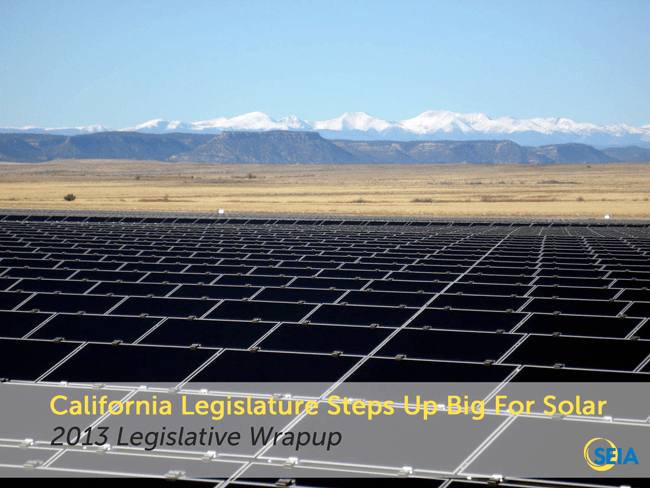California Legislature Steps Up Big For Solar
2013 Legislative Roundup

On average, the sun shines in Sacramento, California, 265 days a year. Well, it looks like even more clear skies and sunny days ahead as the state wrapped up its legislative session on a high note.
Four significant solar-related bills were approved by the State Senate and State Assembly – and all four are expected to be signed into law by Governor Jerry Brown.  These bills will help to foster the continued growth of solar generation in California, which already ranks #1 in the nation in total installed solar capacity with 3,761 megawatts (MW) – three times more than any other state. What’s more, solar now provides nearly 44,000 good-paying jobs across the state, while saving money for hundreds of thousands of Californians on their utility bills.
Here’s a quick recap of the legislation:
- AB 217 (Bradford) — Extends funding beyond 2016 for the California Solar Initiative low-income programs, including the Single Family Affordable Solar Homes (SASH) Program and Multifamily Affordable Homes (MASH) Program. An additional $108 million will be made available through 2021, or until the budget is fully expended (whichever occurs first). The legislation sets a goal of installing an additional 50 megawatts (MW) of solar generation through these programs.
- AB 327 (Perea) — Removes a number of statutorily-imposed residential ratemaking restrictions on the California Public Utilities Commission (CPUC), including authorizing CPUC to approve a monthly fixed customer charge upwards of $10. The bill also includes numerous elements directly impacting solar deployment. These provisions accomplish the following:
1)Â Â Â Authorizes CPUC to procure renewable resources beyond the 2020 33 percent Renewable Portfolio Standard (RPS) target. This clarifies that the RPS is a floor, not a ceiling.
2)Â Â Â Clarifies that Net Energy Metering (NEM) must be offered without interruption to eligible customer-generators until July 1, 2017, or until the IOU reaches its share of the current 5 percent NEM cap, whichever occurs first. This effectively removes the looming 2015 NEM Program suspension.
3)Â Â Â Codifies CPUC methodology for calculating the 5 percent cap.
4)Â Â Â Establishes a process for CPUC to develop and implement new NEM Program rules that will take effect by July 1, 2017.
5)Â Â Â Requires CPUC to establish rules by March 31, 2014 for the grandfathering of existing NEM customers, who took service under the current rules, when new NEM rules take effect. Directs CPUC to protect solar customers under new NEM rules from unreasonable or discriminatory charges.
- AB 792 (Mullin) — Clarifies that all customer-sited Distributed Generation (DG), including 3rd party Power Purchase Agreement (PPA) systems, are exempt from any utility user tax (UUT). The UUT exemption on PPA systems applies until January 1, 2020. Beginning in 2020, a local jurisdiction could begin to collect UUT on all PPA systems, including those installed prior to 2020.Â
- SB 43 (Wolk) — Requires Investor Owned Utilities (IOU) to collectively procure an additional 600 MW of renewable energy through a voluntary Green Tariff Shared Renewables pilot program, which will allow IOU customers to purchase up to 100 percent of their energy needs from renewables. This will expand access to solar and other renewables to customers who currently cannot install on-site clean energy. The bill sets aside 100 MW for projects less than 1 MW in size, to be built in “environmental justice” areas, and reserves 100 MW specifically for residential customers. The bill requires CPUC to determine the appropriate charges and credit values in the Green Tariff, and mandates that options be explored for customers and suppliers to form custom or shared arrangements.
In the final analysis, California has once again proven to be a national leader when it comes to smart, forward-looking solar policies. We applaud the State Legislature and Governor Brown for their continued commitment to clean energy – and a cleaner environment.
Carrie Cullen Hitt, SEIA Senior Vice President of State Affairs
Â


